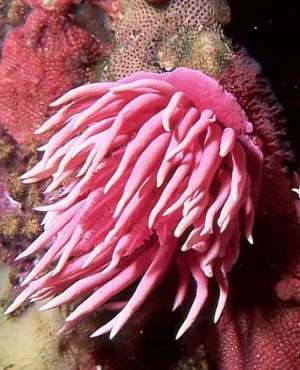
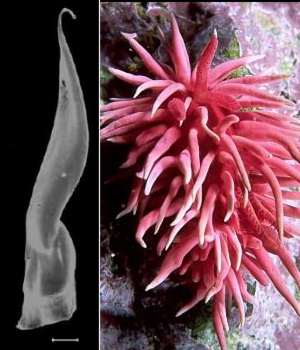
Okenia rosacea
(Macfarland, 1905)
Order: NUDIBRANCHIA
Suborder: DORIDINA
Superfamily: ANADORIDOIDEA
Family: Goniodorididae
DISTRIBUTION
West Coast of Nth America from Oregon south to Baja California.
PHOTO
Upper:off Laguna Beach, California. Animal, approximately one inch long [2.4mm], feeding on the pink bryozoan, Integripelta bilabiata. Photo: Bruce Wight. Lower Right: Shaw's Cove, Laguna Beach, California, January, 2002. Photo: Bruce Wight. Lower Left: SEM of single inner lateral radular tooth. Scale bar = 400 µm. Photo: T.M.Gosliner.
NOTE: This species was previously known on the Forum as Hopkinsia rosacea.
The animal has a low flattened profile and from above, the mantle, foot and head are merged into one, although ventrally a V-shaped groove indicates the junction of the head and the foot. There are no oral tentacles. The dorsal surface is covered with long soft papillae, which taper to a rounded tip. They are numerous near the edge of the dorsum and less so in the central region between between the gills and the rhinophores. The gills and rhinophores are about two-thirds the length of the papillae and similar in shape, tapering to a blunt tip. There are up to 20 simple gills, pointing posteriorly, and arranged in an circle, open posteriorly, around the anal papilla.
The whole of the animal is pink. Often the tips of the dorsal papillae, rhinophores and gills are paler whitish pink. There is some variation in the intensity of the pink, and in some animals there is a considerable amount of white on the papillae. It grows to approximately 30 mm in length.
Although the radula has the typical goniodorid pattern of one large inner and one small outer lateral teeth on each side of a row, the shape of the teeth in O. rosacea is quite unique. The inner lateral teeth are elongate, tapering to a recurved hook-like tip. The outer lateral teeth are reduced to a small vestigial plate. The peculiarities of the anatomy caused MacFarland (1905) to erect a new genus, Hopkinsia, for this species. Gosliner (2004) recently proposed synonymising the genera Hopkinsia and Hopkinsiella with Okenia. Like many of the 'Hopkinsia-group' of species, O. rosacea has a relatively broad flattened body in which the head and foot are fused, the lateral papillae are relatively large and crowded, and the body, like its food, is reddish pink. In external shape, it has many similarities to Okenia hiroi which lives on the western side of the northern Pacific, and they both feed on eurystomellid bryozoans of the genus Integripelta (see Rudman, 2004). The elongate hook-shaped inner lateral tooth of O. rosacea also link it to the recently described central Pacific species, O. nakamotoensis.
Okenia rosacea is usually found associated with a similarly coloured cheilostomatous bryozoan. The colour match is not a coincidence as they both share the same pigment, hopkinsiaxanthin, presumably obtained by the nudibranch from its food (McBeth, 1971). The food bryozoan of O. rosacea is a cheilostomatous bryozoan [Fam: Eurystomellidae] normally named Eurystomella bilabiata. A recent revision of the bryozoans has moved its generic placement so its name is now Integripelta bilabiata (see Gordon, Mawatari & Kajihara, 2002).
- Bertsch, H. (1989) Life history of the intertidal Californian nudibranch Hopkinsia rosacea MacFarland, 1905. Western Society of Malacologists, Annual Report, 21:19-20.
- Gordon, D.P., Mawatari, S. F., & Kajihara, H, 2002. New taxa of Japanese and New Zealand Eurystomellidae (Phylum Bryozoa) and their phylogenetic relationships. Zoological Journal of the Linnean Society, 136: 199-216.
-
Gosliner, T. M. (2004) Phylogenetic Systematics of Okenia, Sakishimaia, Hopkinsiella and Hopkinsia (Nudibranchia: Goniodorididae) with descriptions of new species from the tropical Indo-Pacific. Proceedings of the California Academy of Sciences, 55: 125-161.
-
McBeth, J.W. (1971) Studies on the food of nudibranchs. The Veliger, 14, 158-161.
-
Rudman, W.B. (2004) Further species of the opisthobranch genus Okenia (Nudibranchia: Goniodorididae) from the Indo-West Pacific. Zootaxa, 695: 1-70.
-
Strain, H. H. (1949) Hopkinsiaxanthin, a xanthophyll of the sea slug Hopkinsia rosacea. Biological Bulletin, 97(1):206-209.
ARCHIVE NOTE: An earlier edition of this Fact Sheet [1 May 2000] as Hopkinsia rosacea is available on request.
Authorship detailsRudman, W.B., 2004 (December 21) Okenia rosacea (Macfarland, 1905). [In] Sea Slug Forum. Australian Museum, Sydney. Available from http://www.seaslugforum.net/find/hopkrosa
Related messages
Photos of Okenia rosacea - Hopkins' Rose
February 5, 2007
From: Kevin Lee
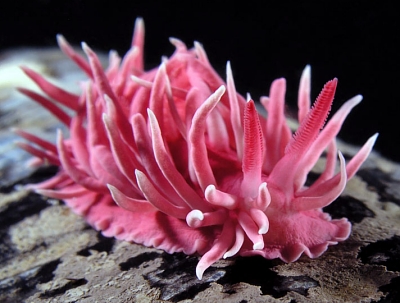
Hi Doc,
The rhinophores and the gills of Okenia rosacea are notoriously difficult to capture as this nudibranch is oft covered with a dense forest of long, like-colored cerata, which camouflage them.
Finally, after a two-hour+ dive, I managed to get some decent fotos of these organs (two individuals) and am pleased to share the attached images.
Also in the second photo some of the cerata seems to be "forked" or has branched into two parts [see close-up]. Was wondering if this is an anomaly or a common occurrence.
Locality: Shaw's Cove, Lagnuna Beach, 20 feet, Califonria, USA, Eastern Pacific, 20 January 2007, Found on mussel shells, between rocky reef walls (Shaw's swim-through). Length: approx. 3/4 inch. Photographer: Kevin Lee.
Best wishes,
K:-)
diverkevin@gmail.com

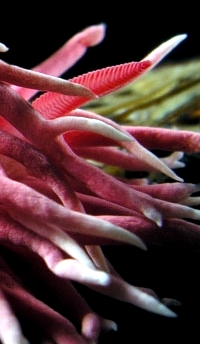
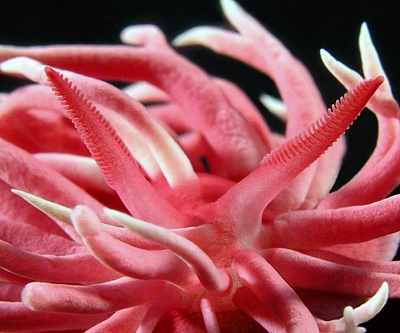
Hi Kevin,
Gorgeous photos. Yes the gills and rhinophores are often difficult to see, leading to many identifying this species as an aeolid nudibranch. Once you see the typical dorid gill plume it is quite obvious.
Now for a nomenclature review. We don't usually use the term 'cerata' for cerata-like structures in dorid nudibranchs. We usually refer to them as 'dorsal papillae'. To be very precise, cerata is usually restricted to the aeolid nudibranchs, where they carry a branch of the liver diverticulum up into their tips. However the term 'cerata' has become widely used for cerata-like structures in many opisthobranchs including the sacoglossans and some non-dorid nudibranchs. Like wings, which have evolved independently in birds, insects, bats etc, not all 'cerata' are the same
The branched papillae in your photo are curious. Anomalies happen. Good observation however. In your close-up of the head, we can clearly see the detail of the rhinophores and even count the 28 lamellae.
Although I really disdain common names, this is one that is special to those of us on this coast. Originally described in the genus, Hopkinsia, referring to Hopkins Marine Station in Monterey, California, where the describer, Dr. Frank Mace MacFarland worked for many of his very productive years. While the nudibranch name is now placed in Okenia where it systematically belongs, another species still carries reference to the marine lab. That species is the the xanthophyll produced by the nudibranch, named Hopkinsiaxanthin, that gives it it's bright pink color.
Thanks for sharing,
Dave Behrens
Re: Okenia rosacea - feeding & breeding
September 5, 2006
From: Phil Garner

Concerning message #15472:
I never realized what their food source was until I got a new camera. I've found a few lately that are laying their eggs next to Integripelta bilabiata.
Locality: Marineland, Rancho Palos Verdes, 45-70 feet, California, USA, Eastern Pacific, 02 September, 2006, Rocky reef. Length: 1/4". Photographer: Phil Garner.
Phil Garner
PacificCoast101@cox.net
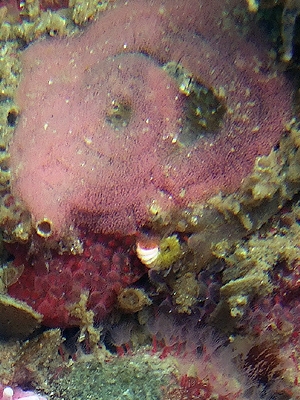

Thanks Phil,
I'm glad you got a new camera. Nice shots of the egg ribbon and the individual bryozoan zooids.
Best wishes,
Bill Rudman
Re: Okenia rosacea - feeding & breeding
December 15, 2005
From: Kevin Lee
Hi Bill...
It was nice playing Santa... your remarks [message #15458 ] are most interesting and I'm pleasantly surprised by your powers of observation i.e. the detailed information you gleaned by studying the photo... now I'm motivated to return to my images and review them with a more discerning eye... By the way, Sea Slug Forum is a great reservoir of information and I intend to use it more often...
Merry Christmas!
Kevin Lee
diverkevin@gmail.com
Lee, K., 2005 (Dec 15) Re: Okenia rosacea - feeding & breeding. [Message in] Sea Slug Forum. Australian Museum, Sydney. Available from http://www.seaslugforum.net/find/15472Dear Kevin,
I can't guarantee to find things in every photo, but I look forward to any more you care to share with us
Best wishes,
Bill Rudman
Re: Okenia rosacea - feeding & breeding
December 14, 2005
From: Jeff Goddard
Hi Bill,
Concerning your comments on message #15458:
Good eye on direction of egg mass laying by Okenia rosacea. As described by Donald Costello in 1938, the egg mass of this species "is deposited ... beginning at the outermost point on the outside whorl, and proceeding in a counterclockwise direction (viewed dorsally) toward the origin or pole." I have not caught a specimen in the act of egg laying, so have not noticed this myself, and to my knowledge, this method of egg mass deposition has not been mentioned for O. rosacea in the literature since Costello's description.
Kevin Lee's great photos also show nicely the egg ribbons laid flat, rather than on edge, a trait shared in the northeast Pacific Ocean with at least Doriopsilla gemela, Crimora coneja, Limacia cockerelli, and a new, deepwater species of Baptodoris that I found off the Washington coast in 2004 and which Sandra Millen is describing.
-
Costello, D.P. 1938. Notes on the breeding habits of the nudibranchs of Monterey Bay and vicinity. Journal of Morphology, 63: 319-344.
Best wishes,
Jeff
goddard@lifesci.ucsb.edu
Goddard, J.H.R., 2005 (Dec 14) Re: Okenia rosacea - feeding & breeding. [Message in] Sea Slug Forum. Australian Museum, Sydney. Available from http://www.seaslugforum.net/find/15464Thanks Jeff,
Another good example of how little we know about even one of the 'flagship' species of one of the most studied faunas in the world. I'm glad Jim Lyle urged Kevin to send in the photo.
Best wishes,
Bill Rudman
Okenia rosacea - feeding & breeding
December 13, 2005
From: Kevin Lee
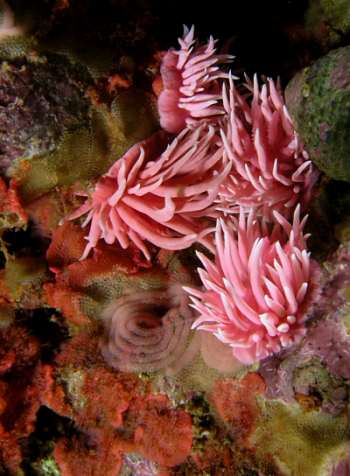
At the urging of Jim Lyle, I post this foto of an aggregate of Hopkin's Roses (Okenia rosacea ) and egg coil. Am pleased to do so.
Locality: Shaw's Cove, Laguna Beach, California. Depth: approximately 15 feet. Length: approx. 1 inch. 27 May 2005. In main swim-through. Photographer: Kevin Lee
Kevin Lee
diverkevin@gmail.com
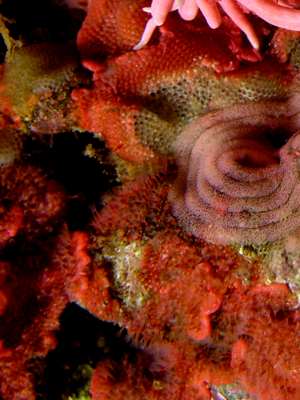
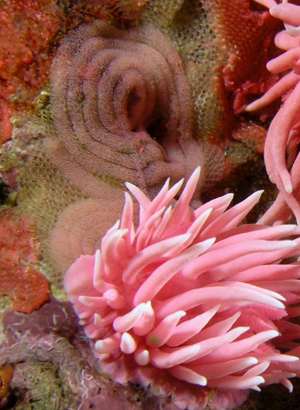
Dear Kevin,
Thanks for this very welcome photo, which shows their food bryozoan, Integripelta bilabiata very well, and also the uncoloured parts that have already been eaten. The egg ribbons are also very interesting, If you look in the lower right close-up photo, we can see part of the egg ribbon leading from the centre of the spiral down to the animal. This seems to me to show that this is one of the species that starts laying its egg ribbon from the outside and spirals inwards to the centre. I suspect this has been observed before - perhaps Jeff Goddard can enlighten us. All in all this photo is a nice Christmas present.
Best wishes,
Bill Rudman
Okenia rosacea or Hopkins Rose
December 6, 2005
From: Michael Jimenez
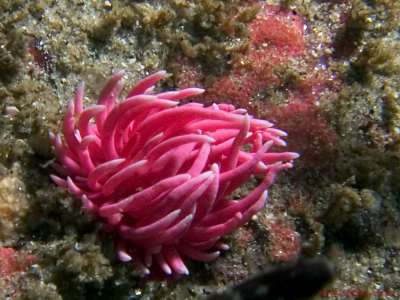
Bill,
I saw that you didn't have a picture of this nudibranch yet. I snapped this one today in Monterey, CA, USA. Sorry for the quality as I used a point-and-shoot today and it was quite surgy.
Locality: San Carlos Beach, Monterey, California, USA. Depth: 12 feet. Length: 1 inch. 04 December 2005. sandy bottom with isolated boulder reefs. Photographer: Michael Jimenez
Cheers.
Mike
mpj17@pacbell.net
Jimenez, Michael, 2005 (Dec 6) Okenia rosacea or Hopkins Rose. [Message in] Sea Slug Forum. Australian Museum, Sydney. Available from http://www.seaslugforum.net/find/15418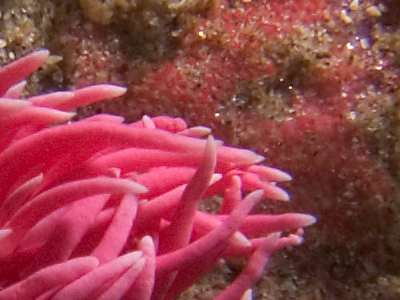
Dear Mike,
Thanks for the photo. I do have this species on the Forum but under its resent name Okenia rosacea. It's a problem when names change whether to leave the old name [in this case Hopkinsia rosacea] in the Species List or not. I decided to remove them, otherwise no one would know which was the correct name. However if you are looking for a name you can't find in the list, use the Forum Search facility and it should find it. I also leave some old Fact Sheets 'in the background' so if you have an old link you will be redirected to the new name. Common names are more of a problem. The Forum Search found 'Hopkins Rose' but I don't as a rule include common names which are often forced on authors by editors and publishers. I've always thought Hopkins Rose is a good example of why not to use common names. This nudibranch looks nothing like a rose, and the 'rosacea' is from Latin for 'rose' as in pink or reddish, not as in a flower. In scientific names the first word is the noun and the second is the adjective. So the common name if based on the scientific name should be the 'rosy Hopkinsia' or 'pink Hopkinsia'. 'Hopkins Rose' misses the point entirely.
However, I shouldn't get carried away fuming about 'common names'. There is no reason to apologise for the photo quality. Your photo is good in showing the reddish bryozoan on which Okenia rosacea feeds, and obtains its rosy colour.
Best wishes,
Bill Rudman
Many new species of Okenia
December 21, 2004
From: Bill Rudman
In the last 3 months four papers have been published describing many new species of the goniodorid genus Okenia from the western and eastern Pacific. Also included is further information on the anatomy and biology on many already named species. One paper (Gosliner, 2004) is causing particular angst because it proposes discarding the genus Hopkinsia, a name dear to the hearts of the 'branchers' of California. In the same review other genera such as Hopkinsiella and Sakishimaia are also shown to be unnecessary. I have followed Gosliner's proposal on the Forum. New Fact Sheets have been prepared for all the new species, and many existing Fact Sheets have been revised to incorporate the new information now available to us. As Fact Sheets are often cited in scientific publications, I am keeping copies of all replaced Fact Sheets as pdf files, which will be available on request if anyone has a need to refer to them.
Listed below are the new Fact Sheets and messages, and the relevant publications.
Okenia brunneomaculata Gosliner, 2004
Okenia purpureolineata Gosliner, 2004
Okenia kendi Gosliner, 2004
Okenia virginiae Gosliner, 2004
Okenia lambat Gosliner, 2004
Okenia liklik Gosliner, 2004
More information is provided on:
Okenia pellucida Burn, 1967
Okenia japonica Baba, 1949
Okenia rosacea (MacFarland, 1905) [formerly Hopkinsia]
Okenia plana Baba, 1960 [formerly Hopkinsia]
Okenia pilosa (Bouchet and Ortea, 1983) [formerly Hopkinsia]
Okenia nakamotoensis (Hamatani, 2001) [formerly Hopkinsia]
Okenia kondoi (Hamatani, 2001) [formerly Sakishimaia]
[In:] Gosliner, T. M. (2004) Phylogenetic Systematics of Okenia, Sakishimaia, Hopkinsiella and Hopkinsia (Nudibranchia: Goniodorididae) with descriptions of new species from the tropical Indo-Pacific. Proceedings of the California Academy of Sciences, 55: 125-161.
Okenia purpurata Rudman, 2004
Okenia vena Rudman, 2004
Okenia mellita Rudman, 2004
Okenia stellata Rudman, 2004
Okenia hallucigenia Rudman, 2004
More information is provided on:
Okenia barnardi Baba, 1937.
Okenia pellucida Burn, 1967
Okenia japonica Baba, 1949
Okenia mija Burn, 1967
Okenia zoobotryon (Smallwood, 1910)
Okenia hiroi (Baba, 1938) [formerly Hopkinsia]
Okenia pilosa (Bouchet and Ortea, 1983) [formerly Hopkinsia]
Okenia plana Baba, 1960 [formerly Hopkinsia]
Okenia echinata Baba, 1949
Okenia virginiae Gosliner, 2004
[In:] Rudman, W.B. (2004) Further species of the opisthobranch genus Okenia (Nudibranchia: Goniodorididae) from the Indo-West Pacific. Zootaxa, 695: 1-70.
Okenia angelica Gosliner & Bertsch, 2004
Okenia cochimi Gosliner & Bertsch, 2004
Okenia mexicorum Gosliner & Bertsch, 2004
More information is provided on:
Okenia vancouverensis (O'Donoghue, 1921)
Okenia angelensis Lance, 1966
[In:] Gosliner, T. M. & Bertsch, H. (2004) Systematics of Okenia from the Pacific Coast of North America (Nudibranchia: Goniodorididae) with descriptions of three new species. Proceedings of the California Academy of Sciences, 55: 412-428, figs. 1-11.
Okenia academica Camacho-García & Gosliner, 2004
[In:] Camacho-García, Y.E. & Gosliner, T.M. (2004) A New Species of Okenia (Gastropoda: Nudibranchia: Goniodorididae) from the Pacific Coast of Costa Rica. Proceedings of the California Academy of Sciences, 55: 431-438.
Bill Rudman
Hopkinsinia rosacea from Catalina Island, CA
February 27, 2004
From: James Lyle
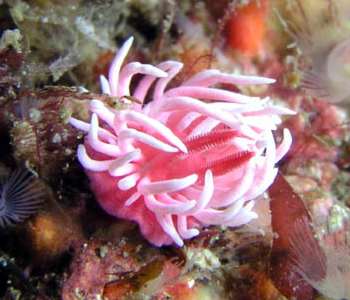
I believe this is Hopkinsia rosacea. It was a very small specimen, about 5mm long. It was found on the side of the wreck of the Valiant located in Descanso Bay, near Avalon, Santa Catalina Island, California. The depth was 90 feet, the water temp was 53 degrees F, and there were no other individuals were spotted on the wreck.
James Lyle
jlyle@scubadiving.com
Lyle, J., 2004 (Feb 27) Hopkinsinia rosacea from Catalina Island, CA. [Message in] Sea Slug Forum. Australian Museum, Sydney. Available from http://www.seaslugforum.net/find/12314Thanks James,
Yes this is Hopkinsia rosacea.
Best wishes
Bill Rudman
Hopkinsia rosacea - food
February 19, 2002
From: Alan Grant

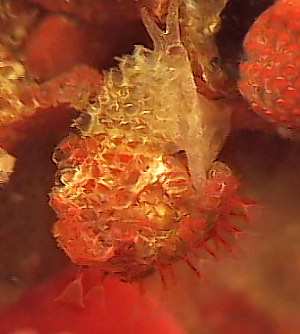
To all:
Here's a single frame from a video clip taken Friday, Feb. 1, 2001 at Shaw's Cove in Laguna Beach [California, USA]. The Hopkinsia is seen at the lower edge dining on this colony of it's favorite bryozoans. Notice the lophophore above the branch.
Alan Grant
dentadive@cox.net
Grant, A., 2002 (Feb 19) Hopkinsia rosacea - food. [Message in] Sea Slug Forum. Australian Museum, Sydney. Available from http://www.seaslugforum.net/find/6232Thanks Alan,
Ii is a nice photo of the bryozoan 'animal'
Best wishes,
Bill Rudman
Information on Hopkinsia rosacea
January 30, 2002
From: Sarah Heinemann
Hello.
I am doing a research project on the Hopkinsia rosacea and wanted to know some more information. I've found a lot about what it looks like, but I need more on if it has any threats in it's habitat, and what adaptations it may need to survive in the future. I am also looking for some more information on its food, the Pink Encrusting Bryozoan, or Eurystomella Bilabiata. If anyone has any information, please write me what you know.
Thank You.
Sarah H.
p.heinemann@verizon.net
Heinemann, S., 2002 (Jan 30) Information on Hopkinsia rosacea. [Message in] Sea Slug Forum. Australian Museum, Sydney. Available from http://www.seaslugforum.net/find/6107Dear Sarah,
Have a look at the Forum's Fact Sheet on this species. There is a reference to a study on its life cycle which may be of interest. You may have to look at some books for information on the bryozoan but it is possible that there is nothing known about the biology of the bryozoan. One important lesson you will learn when researching marine life is how little we know about most species.
Good Luck with your research,
Bill Rudman.
Hopkinsia rosacea from Shaw's Cove
January 30, 2002
From: Bruce Wight

Hi Guys,
Conditions were wonderful last weekend [January, 2002] at Shaw's Cove in Laguna Beach [California] so we made a dive on Sunday and one on Monday. We saw at least twelve Hopkinsia rosacea on each dive. We found one that appeared to have three rhinophores but upon detail inspection of the images it only has two. One is branched forming two independent lamellate sections.
We also found Diaulula sandiegensis our share of Tylodina fungina and Laila cockerelli. Hope you enjoy the attached images that were taken on the two dives. It looks like the high pressure system is going to hold until Friday so this weekend may be good diving as well.
Take care,
Bruce Wight
bwproductions@earthlink.net

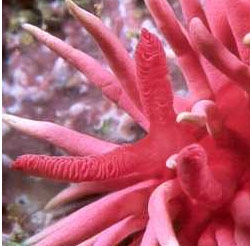
Thanks Bruce,
It sounds like a productive outing. I'll add your 'funny' rhinophores to the Abnormalities Page.
Best wishes,
Bill Rudman
Photos of Hopkinsia rosacea
June 28, 2000
From: Bruce Wight
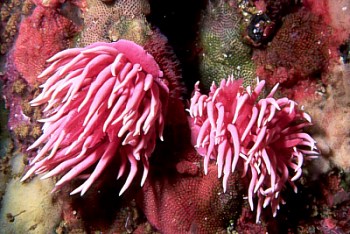
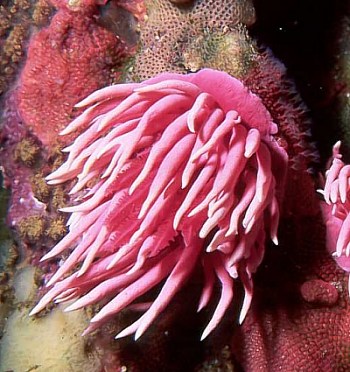
Hi Doc.
I thought I would throw in another seasonally common branch that can be readily found when beach diving off Laguna Beach, CA. The inch long Hopkinsia rosacea [2.4mm] populates the more protected reef area feeding on a pink species of Bryozoan.
Take care
Bruce Wight
bwproductions@earthlink.net
Wight, B., 2000 (Jun 28) Photos of Hopkinsia rosacea. [Message in] Sea Slug Forum. Australian Museum, Sydney. Available from http://www.seaslugforum.net/find/2630Thanks Bruce,
They are certainly spectacular animals. To those of you unfamiliar with this animal, we are looking at its posterior end in the lower photo. The feathery stuctures we can see are the gills.
Best wishes,
Bill Rudman.
A photo of Hopkinsia rosacea
May 4, 2000
From: Dave Behrens
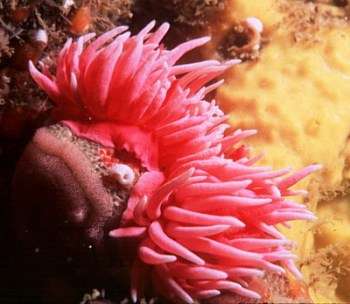
Dear Bill:
Here is a gorgeous photo of Hopkinsia rosacea, with pink egg mass and on its bryozoan prey, Eurystomella. The photo was taken by Dr. Alan Grant, who I know would want this shared with your readers.
My Best,
Dave Behrens
dbehrens@schafercorp.com
Behrens, D.W., 2000 (May 4) A photo of Hopkinsia rosacea. [Message in] Sea Slug Forum. Australian Museum, Sydney. Available from http://www.seaslugforum.net/find/2354Thanks Dave,
For those of you who don't know, there is a larger version of this superb photo on Mike Miller's equally superb Slug Site at http://slugsite.tierranet.com/
Bill Rudman.
Hopkinsia rosacea
May 3, 2000
From: Juniscilla
I was wondering if anyone could give me any information on the sea slug known as the Hopkins Rose
thanx - love u all,
juni
testlaw@aol.com
Juniscilla, 2000 (May 3) Hopkinsia rosacea. [Message in] Sea Slug Forum. Australian Museum, Sydney. Available from http://www.seaslugforum.net/find/2330Dear Juni,
I haven't a photo of this beautiful nudibranch from the west coast of North America but all the books I know of on West Coast nudibranchs have a photo of it. If anyone has a photo of this animal for the Forum, it would be very welcome.
Have a look at the photo of a somewhat similar looking species here on the Forum from eastern Australia.
Hopkinsia rosacea is a bright pink nudibranch which lives and feeds on a similar coloured species of bryozoan, Eurystomella. It grows to about 20mm and has been found from Oregon to Baja California.
If you go to Erwin Koehler's Opisthobranchs of the World - which is a comprehensive list of links to opisthobranch photographs on the web, you will find a number of links to photos of Hopkinsia rosacea.
Best wishes,
Bill Rudman.
